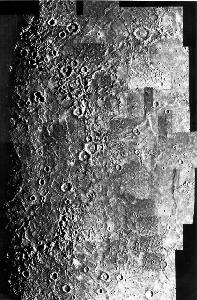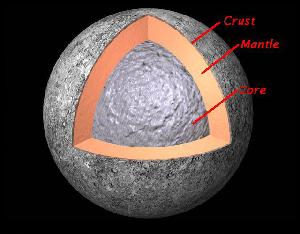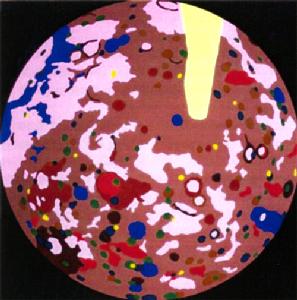Mercury Transit on May 7, 2003 Mercury's Dramatic History What is inside Mercury? Mercury is the planet closest to the Sun and its surface looks very much like that of the Moon. This is because they have both been subject to a large number of impacts, especially when the solar system was still young, some 3-4,000 million years ago. On this page, we will take a look at Mercury's dramatic history and what is inside. You will find more information about the physical properties of Mercury on another page . The great Caloris Basin |  | | Part of the enormous Caloris Basin, the circular feature seen at the left of this Mariner 10 photo mosaic. |
One of the most spectacular surface features on Mercury is the Caloris Basin . It first became known when NASA's Mariner 10 spacecraft sent back the first detailed photos from this planet - a mosaic of some of them is shown above. The Caloris Basin has an overall diameter of some 1300 km. It is covered by concentric "rings" of mountains - some of these ranges are 30 to 50 km long and form "rims" about 2 km high. This large surface formation was probably caused by an impacting asteroid with a diameter above 100 kilometers. It must have been a tremendously violent event. The seismic waves that were produced from the impact travelled through the planet and focussed on the other side of the planet. Exactly opposite the Caloris Basin they produced a strange-looking region that was first described as the "weird" terrain with a chaotic mix of hills and fractures. After the impact the enormous crater was partially filled by lava flows. The Caloris Basin has a wrinkled floor, perhaps representing fractures from rapid cooling of this lava. Some older craters which were "flooded" by the lava outpouring from the Caloris impact are also visible. Both in size and structure, the Caloris Basin very much resembles Mare Orientale on the Earth's Moon. The Caloris Basin gets very hot because it is near the ("sub-solar") point on Mercury's surface that faces the Sun when the planet is closest to the Sun. Altogether, there are more than 20 large, multi-ringed basins on Mercury's surface - many of them are very old and are covered by large numbers of later impact craters. Mercury's Interior |  | | This is how Mercury's interior may look like, with an outer crust over a thicker mantle and a heavy core. |
Although it is rather small, Mercury has a fairly large mass. Its bulk density is therefore quite high: 5430 kg/m 3. This is very similar to that of the Earth and seems to indicate that theirs composition may also be similar. We may probably compare Mercury's interior to that of Earth, with a large metallic core and a rocky mantle covered by a comparatively thin crust. To be sure, it would be necessary to measure seismic waves travelling through Mercury. This has not been done yet, but most scientists believe that the model shown in the above photo gives a good idea of the interior of Mercury. Mercury's history |  | | Geological map of Mercury, showing different surface formations (from Mariner 10 data). |
The basis for reconstruction of Mercury's geologic history are the planet's high density and an analysis of various geological maps. Because of its high density and the close distance to the Sun, Mercury probably consists mostly of iron and silicates. Most scientists believe that one of the earliest events in Mercury's history was the formation of a crust . Just like the Moon, Mercury is thought to have experienced an early melting, the period when the lunar magma "oceans" were formed. At that time, elements of comparatively low density like aluminium moved upwards into the uppermost part of the crust and on to the surface. At the same time, iron and other heavy elements moved downwards and formed a massive core at the centre. During the subsequent cooling of the planet a thicker crust formed. The impact craters and basins which can still be seen today reflect the last phases when Mercury still "collected" material from the outside. These features were then partly covered by material that reached the surface from the interior by way of volcanic activity. This particular period of Mercury's history is called the Pre-Tolstoyan Period . The subsequent geological periods are characterisized by gigantic impact events. The beginning of the Tolstoyan Period is marked by the creation of the Tolstoy Basin , another large impact feature with an diameter of 500 km that is located in the southern hemisphere. It was still a time of high impact rates. The even more dramatic Caloris impact formed the largest well-preserved basin visble on Mercury's surface. The accompanying catastrophic seismic vibrations formed the hilly and chaotic terrain on the opposite side of the planet. Shortly after the Caloris impact, massive extrusions of flood lavas formed the smooth plains. Thereafter, the number of impacts and therefore, the cratering rate, decreased rapidly and from then on, only small changes took place on Mercury's surface. The low rate of cratering presently continues to produce a layer of dust grains of different sizes (the "regolith") that covers all surface features. |
|
|
| | |